Facing the “Great Resignation” and the battle over returning to the office or not, culture change is top of mind for every leader. But most leaders have continued with their past approaches to culture change and employee retention with mandates, reorganization and the belief compensation is the key to employee happiness and motivation.
What is the real secret to changing today’s workplace culture and retaining talent?
Join WorkProud CEO Michael Levy and Roger Martin Thinkers50’s #1 management thinker in the world & strategic advisors to top CEOs to discover a new approach to shape culture and nurture talent in today’s modern business world.
In this webinar you will learn:
You can watch this educational presentation covering issues of the company culture change management. For those who love to read, we prepared the adapted transcript below.
Every time we think about something or make a decision, we use a model of some sort.
For example, this is the Black-Scholes option pricing model:


If you want to learn how this equation works, you can read this article.
Mr. Martin mentions, “I’d like to see you owning your model, which means that the model performs the service you want it to do for you. In this case – it accurately prices an option, so that’s a model that helps you do your business or whatever you’re trying to do. What I don’t want to see happen is for your model to own you. To keep using a model that doesn’t work – that’s when your model owns you, and what I’ve seen out in the world of business is that models don’t have to work for us to keep using them. I see many managers owned by their models and what I’d like to convince you to do is rethink those models.”
Rather than trying to improve that model, how do you shift to a better model that accomplishes what you want?
For the purpose of this presentation, Roger L. Martin picked three models to talk through from his latest book, “A New Way to Think: Your Guide to Superior Management Effectiveness,” consisting of 14 chapters.
The dominant model for Talent that’s out there in the world now is that the way to attract and retain Talent is by paying them at a high rate that is consistent with Talent.
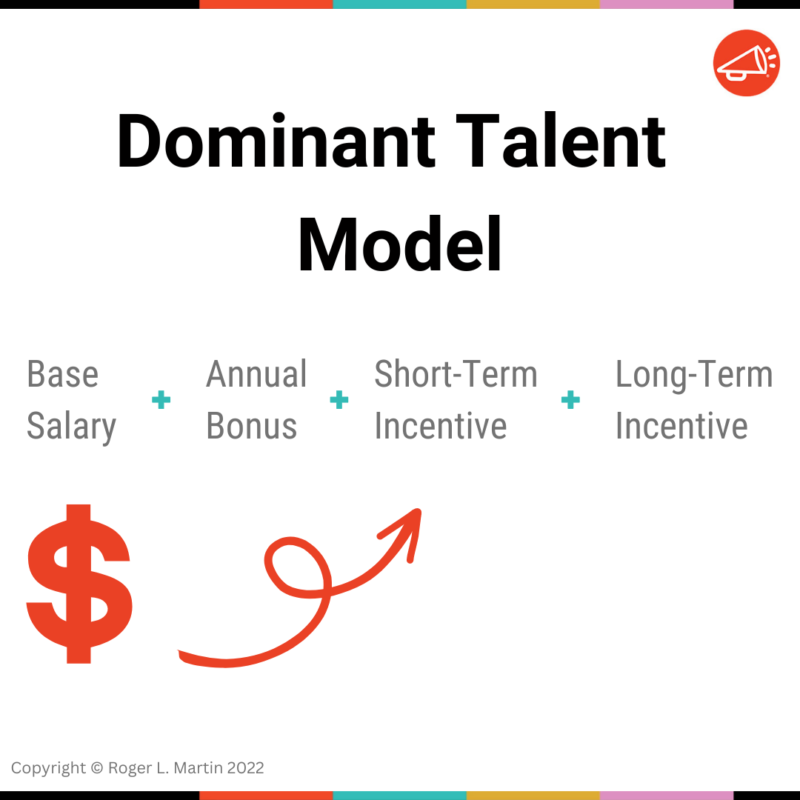

So we spend a lot of time designing the pay: what base salary is appropriate, what kind of annual bonus, what type of structure we have to have, and what sort of short-term and long-term incentive plans we have to put in place.
And that notwithstanding, one of the big challenges of companies is attracting, retaining, and motivating Talent. So why do we keep thinking that this model is working?
According to Mr. Martin, “Feeling special is more important to Talent than compensation. Now notice, I don’t say that compensation isn’t important. They have to feel that the compensation has fairness, but Talent has worked hard to build up a set of unique skills and capabilities. Nobody wants to be treated as part of a class, they want to be treated as something special, and I learned this the hard way.”
There are three things to keep in mind if you want to attract and retain Talent:
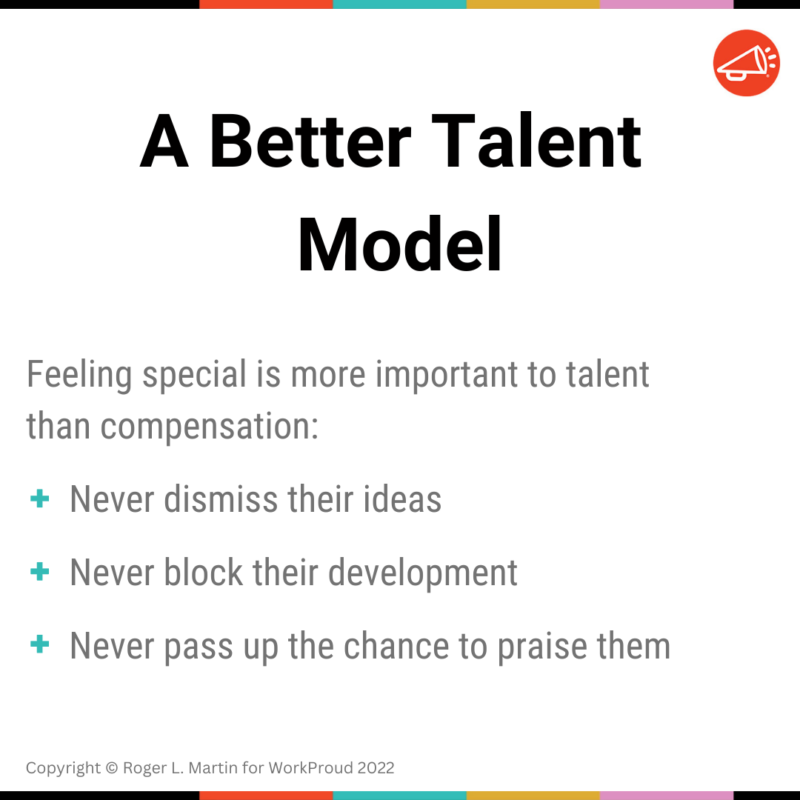

Let’s take the founder of Zoom as an example. As most people know, he was the head engineer of WebEx for Cisco and took part in creating this software.
At a certain point, he realized that things were going mobile, while WebEx, as a desktop service, worked terribly on the mobile platform. So he said the team needed to re-platform it to ensure it works equally well on mobile. The answer from management was: “No! That would cost too much money. We don’t really want to do that.”
So, his idea was dismissed, and he responded the way Talent commonly responds when their ideas are being ignored: “Okay, I’m going to go and carry out my idea elsewhere.”
Now, WebEx by Cisco has got a competitor in Zoom that has vaulted far past them, and they probably will never recover their position. But they could have if they would have just understood the rules of managing Talent.
The number two rule is “never block their development,” and this story is in part a story of dismissing ideas and in part of blocking development. What Ewan wanted to do was the next stage of what he thought needed to be done, and that was blocked, so he went elsewhere.
The third one is somewhat counter-intuitive, which is “never pass up the chance to praise them.” Often Talent looks like they’re succeeding to such a level that people think, “well, they don’t need to be told they’re doing well. They know they’re doing well.” That is not the case at all! They’ve worked as hard as possible to make themselves uniquely valuable and want to be recognized for that. You don’t have to praise them every day, but don’t pass up a chance to praise them when you can.
The general model of the corporation is that the corporation is there for control and coordination. So you’ve got a corporation that’s got groups and business units. Even medium-sized companies might be split into chunks. It might be smaller companies, individual products, or business units.
But the dominant model of the corporation is the job of the top – to set strategy, and then it’s to ensure control and coordination and make sure everybody below is doing what they’re supposed to do.
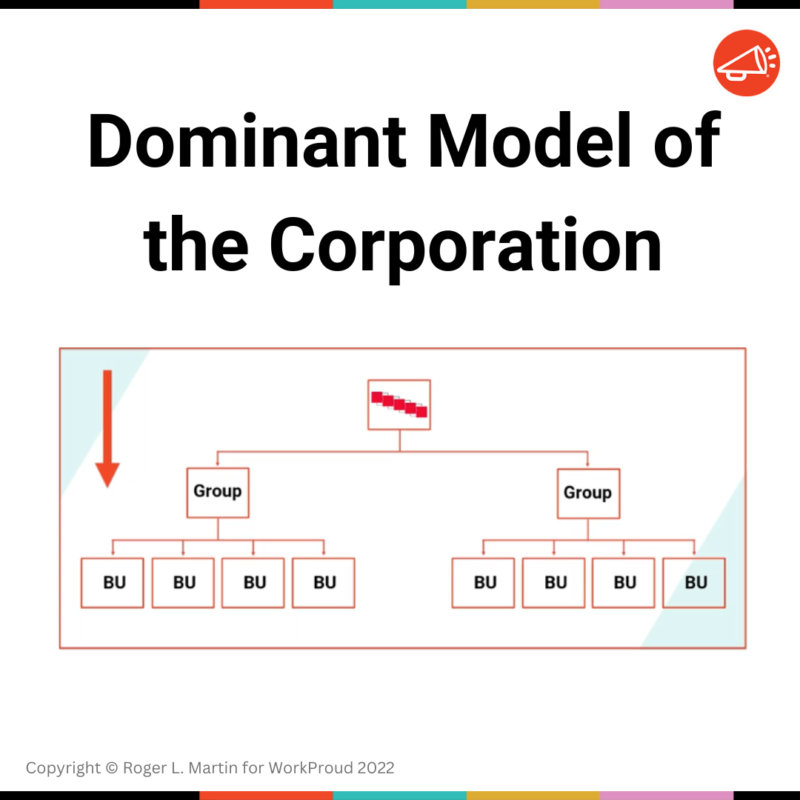

According to Mr. Martin, this model of the corporation causes a lot of problems. In the modern corporation, all the subordinate businesses must create a strategy and make strategic choices. If the top is Procter Gamble and the group is Beauty Care, under Beauty Care, there’s Hair Care, and under Hair Care, there’s Pantene and Head & Shoulders. These two brands have to make strategic decisions. They do more than just what the corporation says. They’ve got to make strategic decisions to win customers at the bottom of the corporation.
So a Pantene customer (Hair Care) is not going to say, “Oh, I’m going to buy Procter & Gamble,” they say, “I’m going to buy Pantene.” Like with bottled water, the customer doesn’t say, “should I buy Coca-Cola water or PepsiCo water?” They say, “should I buy Dasani or Aquafina?”
So the dominant model of the corporation that says, “It’s about we control and coordinate you,” isn’t as helpful as a model that says, “No, our job is to assist that frontline.” Assisting where actual competitive and buyer decisions are made will ensure that the company is as competitive as possible.
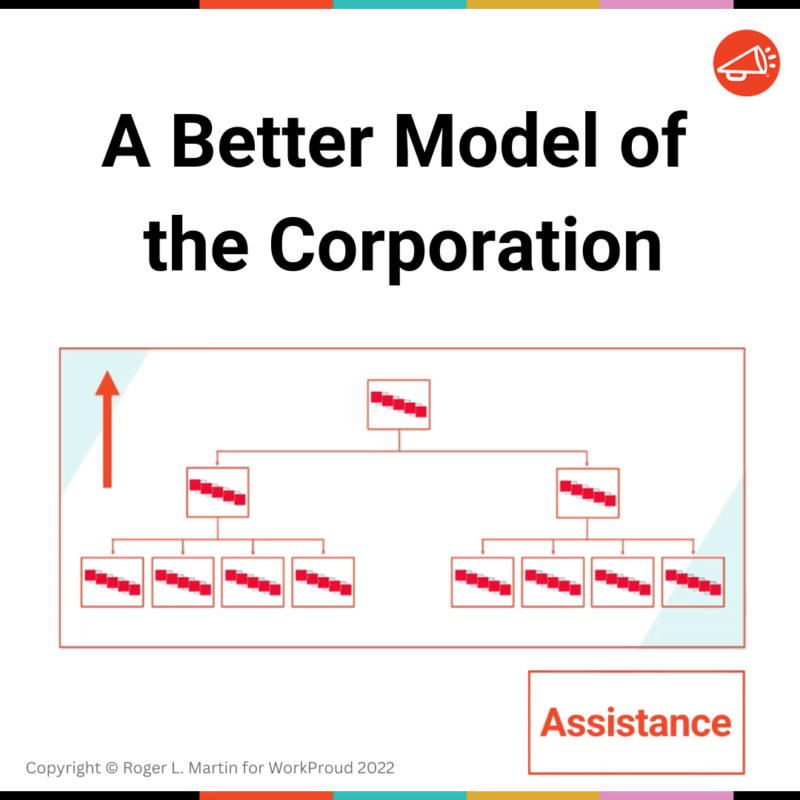

A better model of the corporation is that everybody does strategy, and the managing organizations play a role in helping those businesses compete. If Procter & Gamble is big enough and advertises enough that Pantene can buy advertising at a lower price than its competitor’s brand, Fructis can, then Procter & Gamble assists them. If the customer team they’ve set up got 800 people in Bentonville, Arkansas, at Walmart headquarters that can help sell in the annual program Pantene wants to have in store, then they’ve helped the brand, and Pantene is better off being part of Procter & Gamble than separate.
So, the better model of the corporation is a model that says the key is what happens at the goal phase, and the rest of the company has to assist. But of course, the best model of the corporation is it flows both ways.
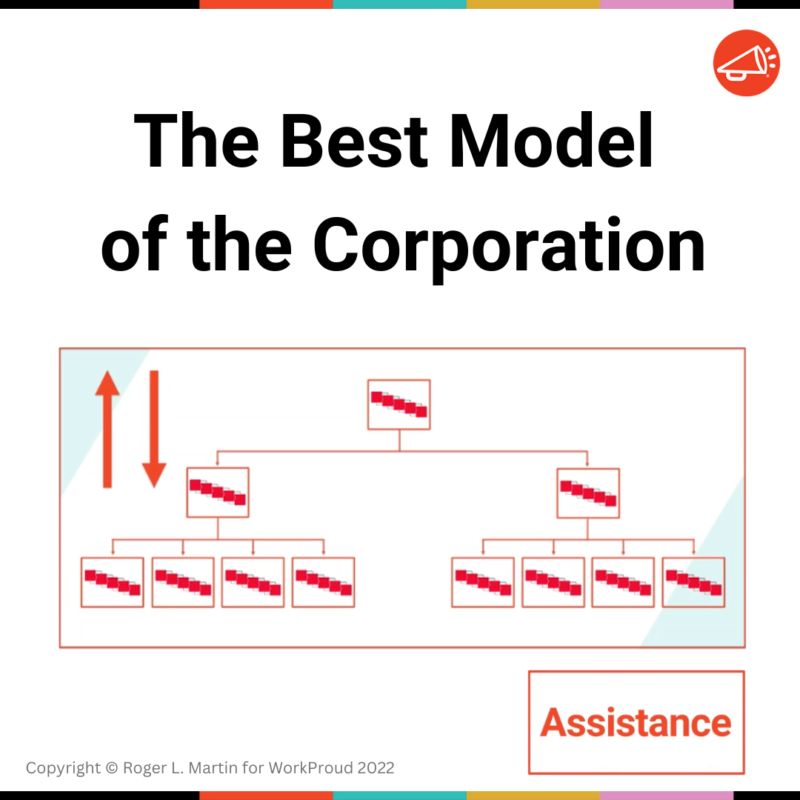

The corporation has to figure out what businesses it can help and have those in the portfolio and those that can’t help – and pump those out of the portfolio. So there’s a top-down and a bottom-up rather than this strict “We make strategy at the top; we’re going to control and coordinate you.”
That is not a helpful view, and that is why so many companies are being broken apart by the capital markets. The capital markets see that it isn’t beneficial at all for corporations.
The dominant model for decisions in the modern economy says that decisions need to be made on the basis of rigorous data analytics. We’ve got to look at the data, determine what the data say, and make a decision accordingly.
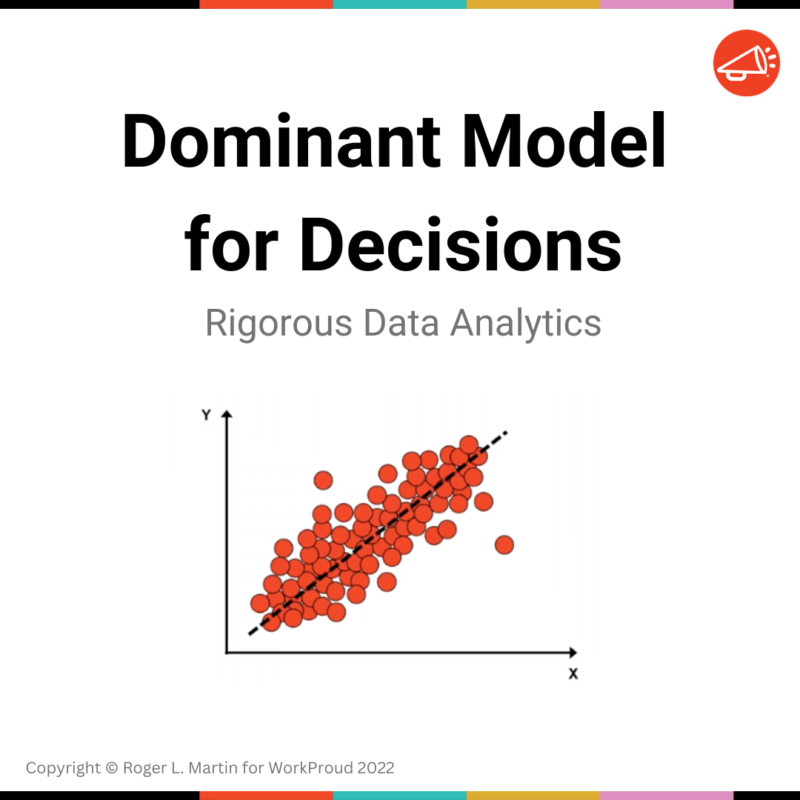

There’s a paradox that has come at the same time. A feeling that all decisions must be data-based lives along with the executive frustration with the level and pace of innovation.
Roger L. Martin emphasizes: “When I talk to the executives I work with and ask them what frustrates them more than anything else, it would be this level and pace of innovation in their organization despite it’s the golden age for disruptive startups.”
So how can both of these happen? If we’re going to use data to make decisions, there’s a point in time when we’re analyzing the data, and then there’s the future. The challenge is that 100% of all data on the face of the planet is from the past. At the time you’re doing the analysis, there is no data about the future. You cannot analyze data about the future because it has yet to happen!
When you use the dominant model that says we can only make decisions based on rigorous data analysis, you’re making an assumption that the future is identical to the past. And how many times in business does that actually happen?
A better model says there are two distinctive parts of the world and they require fundamentally different decision approaches. They’ve been mushed together in the modern world.
And that’s a fundamental error that was pointed out 2500 years ago, so it’s not like this is something new. In the 4th Century BC, Aristotle made this distinction between the part of the world where things cannot be other than they are and another part of the world where things can be other than they are.
And what Aristotle said about the second “part of the world” is, “Do not use the scientific method for that part of the world. You must imagine possibilities and choose the one for which the most compelling argument can be made.”
A completely different way of operating, right? It suggests you have to divide the world and only use analysis for one part. The modern business world uses analysis for everything that happens. If you analyze, you assume that the future will be like the past. Then, you do what you do because you will do whatever the analysis says, as if the future will be identical to the past.
So if you want to think about doing something new, there won’t be any data for that, and you won’t do it. Who will do it? Two kids in a garage who you do not know. And that’s the greatest fear of the modern CEO is being disrupted by a little company that’s not accidental.
That is a result of our dominant model where existing corporations, especially big ones, who have adopted this dominant model convinced themselves not to do new things because there’s no data to support it which opens the field for little folks.
Mr. Martin shares his approach: “I spend a lot of time paying attention to anomalies. In the modern world, our dominant model has caused us to focus our gaze on the averages, the mean, the middle of the distribution because that’s what analysis says is important. It says outliers are unimportant. I believe in watching the outliers, the anomalies because they’re the key to the future. And what I tell the people I work with is we all work up the causal model that explains the mean. I want you to focus on a causal model that explains the anomalies because when you figure out what explains the anomalies, you can figure out the future.”
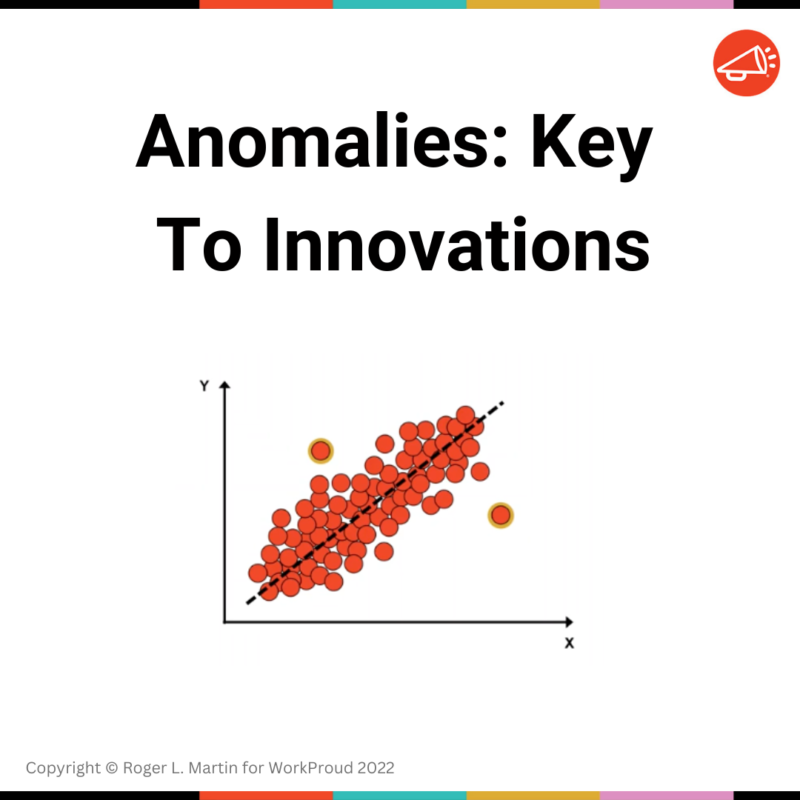

Mr. Martin sums up: “So my core point and closing thought is I want you to take ownership of your models. If a model doesn’t produce the results you expect, don’t blame it on yourself and say I didn’t do it right, I didn’t use the model right. I want you to say that model may just be deeply flawed, and I’m going to think about utilizing another model. And that is what I wrote about in “A New Way to Think: Your Guide to Superior Management Effectiveness.”
We had a hypothesis some time ago. Most people use smartphones, and that device is picked up and looked at, let’s say, 200 times a day. And there’s a reason for that.
So shouldn’t corporations consider winning some of those 200 pickups with positive messages to their workers, like: “That’s a good idea! You’re important! I see you!”
I believe that premise is very sound, plus that scenario can be delivered from an execution standpoint. I would present that idea to people, and they would say, “Totally, I agree,” and then they would give me a hundred obstacles for them doing anything or ask questions like, “Well, what’s the data analysis from last year showing?”
How can executives take your principles and apply them to their particular situations to implement innovative decisions with more confidence?
Regarding discussing the dilemma with the person saying, “Where’s the data to do this? You can’t prove it to me.”
1) I would quote Charles Sanders Peirce, one of the greatest American pragmatist philosophers, who pointed out that no new idea in the history of the world has been proven in advance analytically. Yet, executives typically ask you to do something that’s never been done before on the planet by anyone, anywhere. It’s important to point that out.
2) It’s important to learn the skill of turning the future into the past productively. What do I mean by that? From a data standpoint, the huge problem with the next six months is there is no data about the next six months today.
The good thing about the next six months from a data standpoint is in six months, it’ll be in the past, and there will be oodles and noodles of data about them. If you want to try something new, the trick is to figure out how you can experiment in a way that enables you to observe data in the future.
IDEO, a leading global design & innovation firm, might be the best illustration to explain my thesis. Its co-founders, David Kelley and Moggridge, popularized the notion of rapid prototyping. The concept of rapid prototyping entails putting out a low-cost, low-resolution prototype and asking potential users what they think of it.
That is a perfect example of what I call turning the future productively into the past. Rapid prototyping is also a great way of building confidence in those who would eventually have to greenlight this. Getting skill in that process is what you have to do to be a successful innovator rather than somebody who comes up with ideas that nobody buys.
“Leaders influence but don’t control culture.” Do you believe that? Where does responsibility lie around innovation and cultural evolution?
I agree with the point that leaders influence but don’t control culture. But, they have the most important influence on it.
What changes culture is shaped by the way people interact with one another in everyday work life, and it starts from the upper management. So it doesn’t matter what the stated culture is, it does not matter what the organizational structure is, it doesn’t matter what the compensation structure is.
But there’s a huge difference between cultures, where bosses just give out instructions for their subordinates, and where bosses take time to say things like, “Are you comfortable with this task? Do you understand it?”
A more effective boss would invite subordinates to come back and say, “If you get stuck while doing this, just come back and tell me how and why you’re stuck.” And when subordinates come back with an answer, a more effective boss would pat them on the back if it’s a good enough answer, and if it is not, they’d say something like, “Okay, that’s a good start, now let’s figure out how we can make this better.”
That’s interaction 101. Then you’ll have a culture of more collaboration, less fear, and constant self-improvement.
When Alan George “A. G.” Lafley was CEO of Procter & Gamble, he had a requirement for traveling to any part of the Proctor World. For example, if somebody said, “We’re opening a new factory in Turkey, the president of the country is coming, and we need you at the ribbon cutting ceremony,” A. G. would say, “Yes, but only if while I’m in Istanbul or Ankara, I do an in-home visit where I sit down with a housewife to ask her questions about how she cooks, cleans, etc. I have to have an in-home visit and do a set of store checks, where I walk through stores to see how products are being displayed.”
He never said, “I’m going to change the culture of Procter & Gamble,” he just did it. He tried to make sure the company understood its end customer as well as its trade channel customers. He just did that. So what’s then the head of Proctor Turkey supposed to do? Can they say, “Yes, my boss does that, but I’m too busy for that”? No. And it just changes the culture. But it will only change if senior executives starting at the very top change their behavior.
The extrinsic pride in your work is based on what people would say about you. At WorkProud, we want to help people feel proud of their work and facilitate the possibility of getting positive feedback from their peers, subordinates, leaders, and customers. Our core competence is building company cultures where there’s a lot of good feedback and energy, and people are motivated to give their best. Did you notice a link between a positive company culture and business outcomes in your experience?
I have a view of happiness which is that there’s a “Holy Trinity of Happiness.”
1) A person is happy to the extent that they’re a valued member of a community
2) They value their community
3) People outside it value their community
If a company is smart, they try to make sure that they make their employees happy or contribute to their employees being happy by paying attention to those three things.
I think that relates to your pride point. People are proud to the extent that they are happy members of a community. But unfortunately, this has not been a priority historically because organizations have had other initiatives and agendas to solve, and they’ve mechanized payroll, benefits, training, and other systems. So now they’ve sort of matured in terms of a capability standpoint, and we’re starting to ask those questions pertaining to a big dimension of the employee experience.
It’s the blind spot that’s now becoming more in focus as the labor market challenges happen on one side, and people are asking the questions like, why do I do this job? Why should I stay with this company when the one down the road gives me a little bit more?
This is the last question in this lecture dedicated to shaping company culture, nurturing talent, and change management, conducted by our distinguished guest.
I think it depends on how much you’re trying to change it. It can take a long enough time, but it’s only sometimes necessary.
For example, when I went to become Dean of the Rotman School of Management, it had what everybody thought was a broken culture. There had been a big scandal where the previous Dean had been fired, and there were two warring camps, and I was warned all about how horrible the culture was.
We had it fixed within two or three years. We achieved a stunningly low professorial and staff turnover over 15 years. It just took making sure that everything I did as a CEO was consistent with the culture that I wanted to see.
In the words of Mahatma Gandhi, “Be the change you wish to see in the world.” A CEO has to be the change he or she wants to see or shouldn’t even bother starting.
Help Employees Take Pride in the Workplace – Michael Levy on Modern Company Culture


WorkProud is committed to helping its clients create a unified approach to the employee experience by helping them build cultures of workplace pride. Trusted by millions of users at some of the world’s most recognized employer brands, WorkProud delivers a comprehensive approach to building company cultures that inspire people to be Proud of their Work and Proud of their Company.


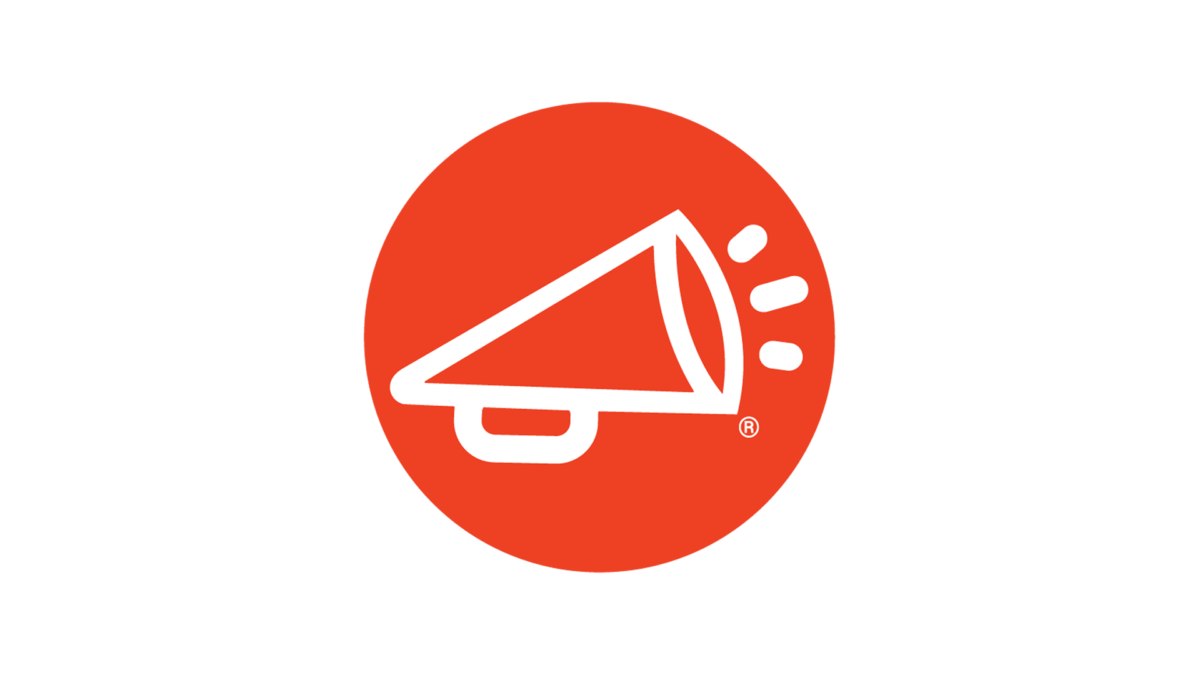

Every month, we share news, knowledge, and insight into what we believe is a pretty simple proposition: If you are “proud of your work and proud of your company,” you are more engaged, more productive, and more likely to stay with your company for the long haul.
*By selecting “SIGN UP,” you agree to WorkProud’s Privacy Policy. You may unsubscribe from our newsletter at any time. Please note when unsubscribing: it may take up to 10 business days for your request to take effect.